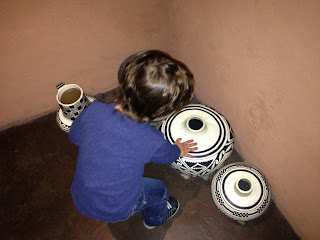
While I draw a lot of my beliefs from my "formal" teaching experience, I don't believe that the walls of a classroom define a teacher and have learned just as much from my recent work as an in home caregiver and in my work teaching in less formal settings such as the children's museum and in after school programs within the city. Because of this, I've always had a bit of a struggle with the ways in which we try to define and separate ourselves in the field of early childhood care and education. In particular, with the ways we use definitions to belittle our colleagues.
In the centers you have teachers, master teachers, lead teachers, assistant teachers, and teacher aides. Then you move into the primary schools and you have teachers, aides, assistants, and paraprofessionals. That doesn't even get into the discussion that often occurs between teachers of kindergarten and up and teachers who teach birth to age 5 in which many people are of the school of thought that those who teach in a center or a home are "only" providers and not teachers. Oh, and let's not forget those nannies, tutors, museum educators, and camp leaders! Let's place them even below the center and home teachers.
Having worked in a government funded program and within a public school, I do recognize that often these labels are used by funders as ways to ensure that certain staffing qualifications are met within the agencies they are funding or by states to find a way to determine teacher qualifications. It becomes a necessary evil to define the levels of education the adults within a learning environment have when trying to determine who may be best suited to lead a particular group of children. And different positions and age groups require different skills and knowledge basis.
Here's where my struggle comes in. It lies in not respecting that all those titles that I listed above bring with them a PERSON who has skills, knowledge, and a desire to work with young children. When we use these definitions to put ourselves above a colleague, it becomes not okay. When we use these labels in the context of saying "well, I'm a REAL teacher because I teach in an elementary school, but you are not because you teach toddlers" or when a lead teacher cannot find value in her assistant teacher's expertise, this is when the problem starts.
We know that early childhood education is important-I'm sure we could all pull out the facts and figures that support this. What we tend to forget is that early childhood is birth through age 8. That means the folks who teach and care for children from birth through third grade are supporting this important time period. This means that we must all work together and that we must all respect the work that each other does. Regardless of what our title may or may not be.
Consider this, Merriam-Webster Dictionary defines the verb "to teach" as the following:
1. to cause to know something, to cause to know how, to accustom to some action or attitude, to cause to know the consequences of an action
2. to guide the studies of
3. to impart the knowledge of
4. to instruct by example or experience, to make known and accepted
Now, to me, this definition describes every single one of the variations on the term teacher that I listed above. Everyone of those people that I listed is a teacher of young children. Everyone of those people is the embodiment of the definition "to teach".
Let's start respecting and supporting each other, regardless of what our official title may be. Only then can we support our young learners and their families.
And let's face it, our young learners are often much better at this than we are. As I was writing this post, I asked some friends of mine on Twitter to read it before I sent it out into the world. As a wonderful and timely example, from one of those conversations came the following story from @happycampergirl's classroom:
C: My dad is my teacher.
P: No he’s not, Mme Amy is your teacher. And Mme Chantal. You dad’s not even a teacher. He’s on the radio. (C's dad is a radio DJ.)
C: Yeah, but at home, my dad teaches me things. So he’s a teacher, then, right?
And those little voices sum it up better than I ever could; a teacher is someone-anyone who teaches you something.
Huge huge thanks to
@tori1074 @happycampergirl for reading the post, encouraging me to publish it, and for inspiring me!

















































